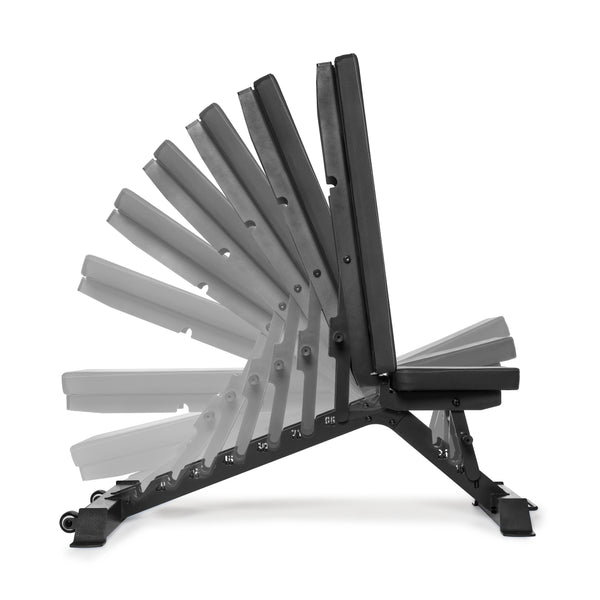If you're a home gym owner who's serious about pumping iron, you've probably come across the terms "flat bench," "incline," and "decline" while researching your workouts. But what do these terms really mean, and how do they affect your gains?
Fear not, my fellow iron enthusiasts! In this article, we'll break down the differences between these bench positions, explain which muscles they target, answer some commonly asked questions, and even give you the lowdown on what to look for in an adjustable bench for your home gym.
So grab your protein shake and let's dive in!
Ah, the flat bench press, the tried-and-true staple of weightlifting routines. This exercise involves lying flat on your back and pushing a barbell or dumbbells up from your chest. The flat bench primarily targets your pectoralis major (the chest muscles), triceps, and anterior deltoids (the front shoulder muscles). It's an excellent compound movement that builds upper body strength and size.
If your ultimate goal is to build a bigger bench press, opt for a Powerlifting Flat Bench or Hero Heavy-Duty Weight Bench. Both of these options work perfectly in a power rack and offer the support and stability you need to move big weights. While push-ups are great for developing upper body strength, they don't offer the same level of intensity and muscle recruitment as the flat bench press.
Push-ups primarily target the chest, shoulders, and triceps, but they also engage the core and stabilizer muscles to a greater extent. If you have access to a barbell or dumbbells, incorporating the flat bench press into your routine will help you take your gains to the next level.
The incline bench press is like the flat bench's sophisticated cousin. This variation involves adjusting the bench to an inclined position (around 30 to 45 degrees) while performing the same pushing motion. By changing the angle, you shift the focus to the upper chest muscles, specifically the clavicular head of the pectoralis major. The incline bench also engages the anterior deltoids and triceps, albeit to a slightly lesser extent.
The Flat / Incline / Decline Weight Bench offers seven adjustable angles to help you target the upper chest. If you’re keeping the weights (and budget) light, the Adjustable Utility Bench will do the trick.
Well, if you want a well-rounded chest and that coveted "fullness" in the upper pecs, then yes! Targeting the upper chest helps create a more balanced and aesthetically pleasing physique.
Plus, a stronger upper chest can enhance your overall pressing strength, which translates into improved performance in other exercises like the flat bench press.Now, let's head in the opposite direction—downhill, that is. The decline bench press involves adjusting the bench to a declined position (usually around 15 to 30 degrees) while performing the pressing motion.
By doing so, you shift the emphasis to the lower chest muscles, known as the sternal head of the pectoralis major. This variation also works the triceps and anterior deltoids, but with a lower emphasis compared to the flat and incline benches.
The bestselling Buzz-Saw Heavy-Duty Adjustable Bench now offers a decline setting with a burly 1000lb weight capacity for those big lifts. Well, it's not absolutely essential, but incorporating the decline bench press can help target the lower chest and create a more balanced look. Just remember, the lower chest is often more challenging to develop, so including decline presses can give you that extra edge.
Plus, who doesn't want a well-sculpted, chiseled chest that turns heads at the beach? Now that you're well-versed in the differences between the flat, incline, and decline benches, it's time to find the perfect adjustable bench for your home gym. Here are a few things to consider:
- Stability: Look for a bench with a sturdy frame and a wide base for maximum stability during your lifts.
- Adjustability: Ensure that the bench offers a range of incline and decline positions, as well as a reliable locking mechanism to keep it securely in place.
- Padding and Upholstery: Opt for a bench with comfortable padding and durable upholstery that can withstand heavy use.
- Weight Capacity: Check the weight capacity of the bench to ensure it can handle your lifting goals.
- Compactness and Storage: If space is limited in your home gym, choose a bench that is easy to fold and store when not in use.
Remember, investing in a quality adjustable bench will not only enhance your workouts but also provide you with a versatile piece of equipment that allows for endless exercise variations.
So, my fellow home gym warriors, now you know the differences between the flat, incline, and decline benches, the muscles they target, and what to look for in an adjustable bench. Armed with this knowledge, you can take your lifting game to new heights and sculpt a physique that will make even Hercules envious. Get out there and crush those weights!



